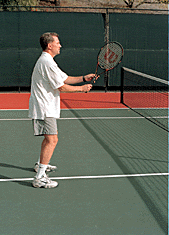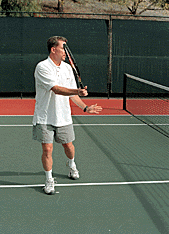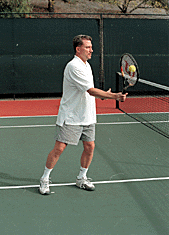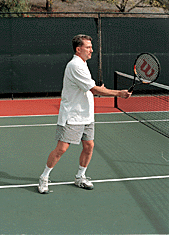Theories of the Game
![]()

Go to Part 1 Part 2 Part 3 Part 4 Part 5 Part 6 Part 7 Part 8 Part 9 of the Visual Tennis Series on TennisONE
(Click here) to see animation of Underspin Forehand Volley)
One of the basic premises in the Visual Tennis approach is to keep the model motions as
simple as possible, and reduce the number of variables to the absolute minimum. In a
previous article, we presented the core positions and images for hitting a basic, or flat
forehand volley. In this article, we will show you how to develop the underspin or slice
forehand by changing to a continental grip and altering only a single element in the
motion. Underspin is necessary for hitting low or touch volleys. Advanced players
also use it for control in high velocity exchanges.
As with the basic forehand volley, the underspin forehand volley is struck with a simple hitting position that remains unchanged throughout the course of the motion. This means the elbow is bent and tucked into the waist and the wrist is laid back. The only difference compared to the motion for the flat volley is that the hitting arm position is rotated slightly backward so that the racket face opens about 30 to 45 degrees to the court.
If you do not already use it at the net, begin by changing to the continental grip, which is halfway between the classic forehand and backhand grips. The continental grip places the heel pad of the racket hand partially on the top bevel of the frame. The index knuckle is also rotated a half bevel or slightly more toward the top of the frame.
Like the flat volley, the preparation or turn is achieved through a unit turn: a shoulder turn and a step sideways with the right foot. As the turn begins the hitting arm is rolled slightly backwards (or from the left to the right) until the racket face is open 30 to 45 degrees. This open racket head position is thus set at the completion of the turn. Once this position is established, the palm of the hand and the shoulder can push the arm and racket forward to the contact point, with the angle of the racket head creating underspin automatically in the course of the motion. The internal position of the hitting arm remains unchanged--elbow in, wrist back. The contact point should be a foot to a foot and a half in front of the plane of the body. The open racket face creates underspin naturally as it moves through the line of the shot. Visualize the racket face as a knife blade and the ball as an orange. As the racket moves through the line of the shot, the knife slices into the orange, cutting off the diagonal back third. This generates underspin or slice.
Below, the underspin forehand volley is broken down into 4 key positions with specific checkpoints. For each position, establish the checkpoints physically. Now close your eyes and create an internal mental image of how the position looks inside your mind's eye, and especially how it feels. Execute the entire swing pattern with your eyes closed. Let your internal imagery and feeling for the checkpoints guide the motion. You should practice in front of a mirror and compare the motion to the checkpoints until you can execute it naturally and automatically. Focus on the open racket face moving forward through the shot at the same angle. The internal mental image of the hitting arm and open racket face can now function as a key to executing the stroke on the court. The process of visualizing a key image can occur in the split second in which tennis players actually execute strokes, particularly at the net, where the exchanges are so much faster. Start in a controlled drill situation with an easy feed from a partner, teaching pro or, if possible, a ball machine, and work up to more difficult balls. Using these images will give you a way to produce high level underspin forehand volleys even under competitive pressure.

READY POSITION SIDE VIEW
A good balanced ready position is critical to preparation at the net. Note that the tip of the racket is even with the top of the head, and the elbows are relaxed and slightly bent. The feet are a little wider than shoulder width and the knees are flexed. For the underspin volley, the player begins with the continental grip in the ready position.

TURN POSITION
Underspin hitting arm position at the completion of the preparation or turn. The preparation has been completed by a step to the right with the right foot, and the rotation of the shoulders. The palm of the hand and the hitting arm have rotated slightly backward, opening the racket face. Note the key checkpoints: The shoulders are about 45 degrees to the net. The elbow is relaxed and tucked in toward the waist. The wrist is laid back. The plane of the racket is almost even with the edge of the front left shoulder, with the face of the racket open about 30 to 45 degrees to the court.

CONTACT POSITION
The player has stepped forward into the line of the shot with the left, front foot. The palm of the hand and the right shoulder have pushed the open racket face forward to the contact point. The hitting arm position is unchanged--elbow in, wrist back. The racket head will now impart natural underspin or slice. The contact is well in front of the body. Contact in front is the key to generating pace as well as spin.

FINISH POSITION
The finish on the underspin forehand volley is compact, virtually identical to the flat volley, except for the angle of the racket face. The palm of the hand and the shoulder have continued to push the racket so that it travels slightly past the contact point, with the butt of the racket just past the edge of the left front leg. The racket face is still open, with the hitting arm position unchanged, elbow still bent and wrist laid back. Watch in the animation how the angle of the racket face, driven by the shoulders and the palm of the hand creates a forehand volley with underspin and also good "stick." The result: controlled power and winning placements.
Send email to the author
We encourage you to email your comments (pro, con, appreciative, whatever) directly to the author. To send email to John Yandell, click here.
To see John Yandell's Pro Tennis video series, go to: http://www.protennisvideo.com
Back To TennisONE Home Page
What's New | Tennis
Lessons | Tennis in Your Area
| Tennis Fitness
Tennis Products | Other Tennis Sites | Sponsors/Advertisers/Consultants | Advertising
TennisONE© is a trademark of TennisONE© and SportsWeb ONE©.
Copyright© 1995. All rights reserved.